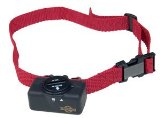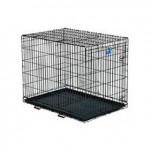Tips for taking home your new puppy
Remember these tips to make your transition go well:
* Limit the space in the house where the puppy gets to go. Expand it over the next few weeks.
* Walk the dog (not carry) to the door and show where they should potty.
* Potty the pup after every transition – after eating, drinking, playing, sleeping – potty them!
* Withhold food and water after 8 pm, do the final potty around 11pm, and wake yourself (and the puppy) up around 2am to potty again, and then again at 6am. That should do it! You will need to keep this up until the pup isn’t pottying at the 2am time.
* If there is a potty accident in the house DO NOT correct the puppy unless you see it happening! Pups only relate a consequence to the behavior that happened 3 seconds prior. So if you see a puddle, call the pup to you and scold it, you are in essence, scolding the puppy for coming to you.
* Remember this rule – any talking, comforting, and removing from the crate will reinforce the behavior that happened right before (usually crying, whining or scratching at the crate). If you don’t what those behaviors, don’t reinforce them!
* Keep the energy low for the first two weeks. It will feel like you are ignoring the puppy but it is the nicest thing you can do to give them the time they need to acclimate. If you have kids, limit the amount of time they get to interact with the pup.
* Keep the crate open and accessible during the periods of the day where the pup isn’t confined – that way when she/he needs comfort or respite, she/he can retreat there.
* Try to match the energy of the puppy – when they’re quiet do quiet activities (cuddling) and when they’re active do more active things (playing and not cuddling).
* Remember to give them access to food four times a day for the first two months home. Then move to three until 5 or 6 months old and then to twice a day. Feed amount suggested on bag.
* DO NOT keep a collar on a young pup who is confined to a crate – it is a strangulation hazard.
* DO teach leash manners, inside, after the first few days home – just let the leash drag for a day, then pick it up and encourage the pup to follow you, do not tug or reel them in.
* Do consider signing up for a puppy class anytime after the pup is 2 months old.
AND MOST importantly …
Good luck!! Trust your instincts and you’ll do fine.
Barking while Crated
Here’s a note from A. & E.:
We were wondering if you had any advice in regards to barking in the crate. Scooby sleeps in his crate at night and the first 3 weeks he made it thru the night without barking. But recently he has started waking up between 2-5 AM barking. Because we live in a townhome this cannot be something that the neighbors enjoy.
Do we ignore him and hope he stops when we ignore it? Or should we be doing something else?
Barking is one of those things that can be reinforced inadvertently… you don’t think you’re reinforcing it but you are. Any attention to a bark will reinforce it – telling the dog to quiet, trying to soothe the dog and letting it out to see if it has to potty are all ways we can reinforce a dog’s barking. There are things you can do to stop the behavior – first of all make sure the dog is sufficiently exercised prior to crating – imagine how terrible it is for a dog to be confined in a space only large enough to sleep in when they are coming out of their skin with energy. And don’t assume that just because you think the dog is sufficiently exercised it is – most dogs have a much higher need for exercise than their owners realize. For most people I recommend adding a second walk to their daily 1 hour walk. If you are walking much less than this that may be the problem. If the dog is exercised, make sure you are stopping food intake early enough so the dog has a chance to eliminate prior to crating. I usually recommend the last meal of the day be the smallest and to be given around 5pm for a 10 pm bedtime. (I feed twice a day). If there is someone in the home that gets up early, that may be causing the barking – maybe that person can potty the dog and return him to his crate. There are so many possibilities you really need to think about the whole situation from the dog’s perspective to identify the cause of the barking.
 But one thing is certain – dogs do what works and if barking either doesn’t work or is aversive (the reason no-bark collars work) then the behavior will stop. But the behavior must always be aversive or always not work. If it sometimes works and sometimes doesn’t, the behavior will continue and be even harder to stop (think of the people who pull the bar on the slot machines for hours with little payoff – that’s intermittent reinforcement at work).
But one thing is certain – dogs do what works and if barking either doesn’t work or is aversive (the reason no-bark collars work) then the behavior will stop. But the behavior must always be aversive or always not work. If it sometimes works and sometimes doesn’t, the behavior will continue and be even harder to stop (think of the people who pull the bar on the slot machines for hours with little payoff – that’s intermittent reinforcement at work).
So, if the neighbors and you can take it, ignoring the behavior is a good solution. Depending on how you feel about such a product, the no-bark collars will give you the fastest results but you must be certain the dog isn’t indicating a need with the barking, otherwise it is just cruel to collar them.
I wish you luck!
Let me know how it turns out.
-Kristin
Advice on problem dog behavior
I got a request for “advice’ recently that I wanted to post. It is important to always remember that this sort of advice can not be as thorough as that given by someone directly involved with the family or the dog. This advice should also not be used in place of veterinary care or professional dog training.
Hi Kristin,
We adopted Jessa three months ago…she was a stray wandering the streets of Aurora. We don’t think she was a stray for very long, as she didn’t really have any physical or emotional scars. She’s incredibly friendly to all people and other dogs. She loves kids. She’s a very happy and lovely dog. The vet says she’s about a year old, give or take a month or two.
Craig’s List a good resource
I just posted a used dog door on craig’s list…I love craigs list! And saw a lot of dog items for sale. If you are in need of a dog crate, that’s the first place I’d look. I saw lots of nice ones for much less than the original price. Also, if you’re in need of a bike trailer…
 |
 |
Crating Your Dog
 Crates are not bad as some people say – they replicate the idea of a den which dogs naturally dig in the wild. However, no den that they dig includes a door they can’t open. Don’t believe people who say that dogs “love” their crates. No animal likes to be confined against its will. But many dogs learn to tolerate their crates and will go in willingly when asked. Some even go to them when they are tired on their own. But when we shut that door we take away their freedom and they know it. They comply because that is what makes them the amazing creatures they are – they trust us implicitly.
Crates are not bad as some people say – they replicate the idea of a den which dogs naturally dig in the wild. However, no den that they dig includes a door they can’t open. Don’t believe people who say that dogs “love” their crates. No animal likes to be confined against its will. But many dogs learn to tolerate their crates and will go in willingly when asked. Some even go to them when they are tired on their own. But when we shut that door we take away their freedom and they know it. They comply because that is what makes them the amazing creatures they are – they trust us implicitly.




